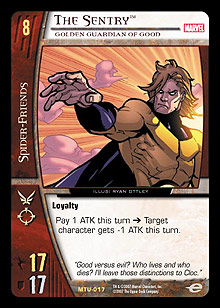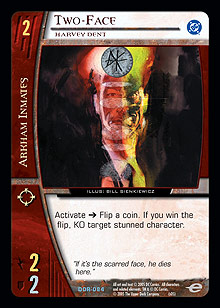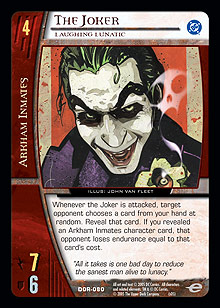
|
The Sentry™
Card# MTU-017


While his stats aren’t much bigger than those of the average 7-drop, Sentry’s “Pay ATK” power can drastically hinder an opponent’s attacking options in the late game.
Click here for more
|
|
|

|
|
|

 |
 |
|
|
| |
This is part two of my mini-guide to alternate formats for Vs. System. Following up on the article I wrote a couple of weeks ago on alternate Constructed formats, this week I’ll look at various Draft formats aside from the basic Sealed Pack and Booster Draft formats in the rulebook.
Rochester Draft
I’ll start with what is perhaps the most common of alternate draft formats, the Rochester Draft. Rochester Draft is very similar to regular Booster Draft, except for one tiny detail—you can see all of the cards as they’re drafted!
 There are two basic ways to draft Rochester style. The first is to open a pack and lay it out on the table. Everyone has fifteen seconds to examine the cards, and then, starting with player one, each player picks a card, revealing the pick to the rest of the table and then placing it face down on a pile in front of him or her. When the pack is empty, player two opens his or her pack and lays it on the table. You continue doing this pack by pack until every card has been drafted, and then everyone builds a minimum 30-card deck from his or her pile. There are two basic ways to draft Rochester style. The first is to open a pack and lay it out on the table. Everyone has fifteen seconds to examine the cards, and then, starting with player one, each player picks a card, revealing the pick to the rest of the table and then placing it face down on a pile in front of him or her. When the pack is empty, player two opens his or her pack and lays it on the table. You continue doing this pack by pack until every card has been drafted, and then everyone builds a minimum 30-card deck from his or her pile.
The second way to do a Rochester Draft is best with two players, though it can be altered to fit more. This version will not work with more than four players, and two is really the optimal number. You open all of the packs and, without looking at the cards, shuffle the cards and place them face down. Player one draws the top four cards and picks one, putting it face down on his or her pile and passing the remaining three to player two, who picks two cards, puts them face down in his or her pile and passes the last one to player one. Repeat these steps and alternate which player picks cards first. For every extra player in the draft, add two cards to the number of cards that the first player draws from the stack.
Rochester Draft adds an extra layer of strategy, because you know what your opponents are drafting and they know what you’re drafting. This means that drafting becomes defensive; you not only want the best cards for your deck, but you’ll want to hate-draft to a certain degree, trying to make sure your opponents don’t get the cards they need for their decks. Additionally, since you know what decks your opponents are gunning for, this gives you a chance to prepare in advance by drafting cards to deal with potential matchups.
Rochester Draft is an acquired taste. I love playing Rochester Draft because I think it’s a much more challenging format, which is exactly why many players dislike it. With so much information literally on the table, it makes it a lot harder to draft a solid deck and to perform against players who know what’s coming. It really balances the field, and separates those who know how to draft from those who are lucky or who make up for a lack of draft skills with surprise and power drafting. The idea of an open draft also cuts down on the possibility of cheating and makes players think a lot more carefully while drafting certain cards—or leaving them on the table.
 Blind Rochester Draft Blind Rochester Draft
If Rochester Draft is a tough format, Blind Rochester Draft is even tougher. Like the second form of Rochester Draft discussed above, this is also best with two players, but it can be altered to fit more players in. This form of two-player Rochester Draft is better suited to four or eight players than the non-blind version. In Blind Rochester Draft, you open all of the packs and, without looking at the cards, shuffle them all together and put them face down in a pile. Then, player one draws the top four cards and lays them face up on the table. He or she picks one card and lays it face up in his or her pile. Player two follows by picking two cards, and then player one takes the last card. Add two more cards to the initial draw for every additional player who’s drafting.
The major difference between this type of two-player Rochester Draft and the straight type of Rochester Draft is that the cards are not hidden. They’re not only face-up on the table, but, unlike the straight style, you don’t have a secret first pick. Like the straight style of Rochester Draft, you know exactly what your opponent is drafting and can draft your deck accordingly.
It’s ironic that this version is called “blind,” as it’s the most open and revealing of Rochester Draft styles. You have to be one hundred percent on your game to perform well in this style of Rochester Draft, as everything literally is on the table. When you draft using this version, you have to be very familiar with 30-card deck strategies and you have to know the cards very well. Synergy is everything in draft decks, and synergy is even more important when drafting “blind.”
 Auction Draft Auction Draft
Welcome to Rotisserie Vs. System, which is not to be confused with the actual draft style called “Rotisserie Draft.” That doesn’t really work when you’re drafting Vs. System. Rotisserie Draft involves drafting an entire set, and there aren’t enough cards in a single Vs. System set to manage it. Factions, loyalty, and team restrictions make a Rotisserie Draft even more difficult. However, an Auction Draft is an entirely different kettle of fish. It involves a different type of strategy—that of gambling. Not real gambling, but virtual gambling. And not gambling as in “game of chance,” but gambling as in risk-taking and guesswork.
The Auction Draft’s method should be familiar to those who love fantasy sports and Rotisserie leagues. Everyone has three packs, just like in a normal draft. Everyone also has a wad of cash. Using Monopoly money makes it easier to keep track of than to simply write down the numbers. Two hundred dollars is the average amount, but that may vary depending on how many players you have and how crazy the players are. (Note: The money is virtual—using real money would not be good.) You’ll also need a Banker (the head judge or tournament organizer, if he or she isn’t playing) to oversee the draft and keep track of the virtual money. This style of drafting works best with four players. It can be done with eight as well, though be advised that it will take longer.
Player one opens his or her first pack and lays all of the cards out on the table. He or she bids on one of the cards. Then player two has a chance to bid on that card, followed by player three, and so forth, until everyone has passed. The winner places the card face up in his or her pile, and now player two bids on one of the remaining cards. Repeat this process until every card is gone, or until nobody wants any of the remaining cards. If there are cards left on the table that nobody wants, the player who opened the pack takes the remaining cards.
Now, player two opens his or her pack and bids on one of the cards. This process continues until every card in every pack is in somebody’s pile. If you can’t afford to pay for a card, you can’t bid on it.
This kind of drafting takes a lot of strategy—and being a math major doesn’t hurt, either. It’s easy to get overzealous and bid everything you have on that Savage Beatdown, but if you do, you may end up with 29 other useless cards in your deck. Auction Draft is all about balance. It balances drafting, hate-drafting, and your virtual wallet. How badly do you want the card, how important is it in your deck or your opponents’ decks—and how much can you spare to take it? Sometimes it’s best to let an opponent waste a ton of money on one good card knowing that he or she won’t be able to outbid you on the next three cards.
 This kind of drafting is immensely fun and is open to all sorts of variations. One of the great variants is the Silent variant, where financial strategy takes on a whole new meaning. In Silent Auction Draft, player one opens his or her pack as normal and lays the cards face up on the table. But rather than open bidding, everybody writes a bid on every card in the pack, from zero upwards, as long as the bid total on the entire page does not exceed all of your available virtual money. Once everyone is finished recording their bids, they pass their sheets to the Banker, who tallies up the bids and awards the cards to all of the winners. If there is a tie, then the player who had more money in his or her “wallet” before the round gets the card. If there is still a tie, the player who opened the pack gets priority, with priority passing to his or her left, player by player. This kind of drafting is immensely fun and is open to all sorts of variations. One of the great variants is the Silent variant, where financial strategy takes on a whole new meaning. In Silent Auction Draft, player one opens his or her pack as normal and lays the cards face up on the table. But rather than open bidding, everybody writes a bid on every card in the pack, from zero upwards, as long as the bid total on the entire page does not exceed all of your available virtual money. Once everyone is finished recording their bids, they pass their sheets to the Banker, who tallies up the bids and awards the cards to all of the winners. If there is a tie, then the player who had more money in his or her “wallet” before the round gets the card. If there is still a tie, the player who opened the pack gets priority, with priority passing to his or her left, player by player.
Auction Drafts are not for the impatient, the emotional, or the over-zealous. They take a while to set up, but the drafting can be just as much fun as the tournament! I highly recommend it as a change of pace from the regular Booster Draft routine.
Double Draft
This is literally a double draft—you draft five boosters instead of the normal three. You make two decks instead of one, marking on your deck registration sheet which deck is Deck A and which is Deck B. The rounds are played as best of five games instead of three. The first game is Deck A vs. Deck A, the second is B vs. B, the third is A vs. B and the fourth is B vs. A. If you need to play the fifth game, your opponent chooses which deck you must use, and vice versa.
This format is a little harder than regular drafting, as you have to focus more on the long-term strategy of the draft. You have extra packs coming, so you can afford to be a little more conservative with your picks, but you have to draft enough playable cards for two decks. And if one of your decks is missing key components, it will mean the difference between an easy win and a strong showing. Remember, you will have to face off against opponents who have two solid decks.
That’s it for this week. I hope everyone has fun testing out these formats! My personal favorite is Blind Rochester, with Silent Auction a close second. Try them all and compare them to the normal draft formats—you won’t be disappointed with these alternatives to the status quo.
Next week, I’ll take a look at how the metagame affects the casual player.
Note: I’m still looking for questions and concerns from the community—if there’s anything you’d like answered or addressed, please send me an email at kergillian@hotmail.com.
Also known by his screen name, Kergillian, Ben Kalman has been involved in the Vs. community since Day One. He started the first major player in the online community, the Vs. Listserv, through Yahoo! Groups, which now boasts well over 700 members! For more on the Yahoo! group, go to groups.yahoo.com/group/Marvel_DC_TCG.
|
| |
| Top of Page |
|
 |
|
|
 |